The Dallas-Fort Worth metroplex is one of the fastest-growing metropolitan areas in the United States. Denton, Tarrant, and Collin counties are all seeing a mass influx of people and businesses. At the heart of it all is Dallas County. Dallas County and the surrounding areas are not just growing in population, but property values are thundering to new heights to accommodate the new demand.
Under the watchful eye of the Dallas Central Appraisal District (DCAD), property values and taxes have been hitting record highs. According to DCAD, residential property values increased by 5.6% in 2025, while commercial property values went up a staggering 15.1%. To dispute and counter these numbers, property owners of all stripes filed property tax protests. In this article, we will see how the appeals have affected property values so far. It should be noted that currently only informal appeals are being counted, along with a few formal ones. Appeals to the appraisal review board (ARB) are currently ongoing and will be for months.
Appeals Slow Resident Values by 0.7%

According to DCAD, residential properties in Dallas County totaled $251.03 billion in market value, an increase of 5.6% from 2024. Informal appeals were launched through May 15, 2025, and were able to reduce this new number by 0.7%, which equals $1.94 billion in value. Homes worth between $250,000 and $500,000 are the largest reservoir of residential value at $104.63 billion. These were protested and reduced by 0.3% to $104.32 billion. The largest cut came from homes that are worth over $1.5 million. These were reduced by 1.3% or $898.34 million.
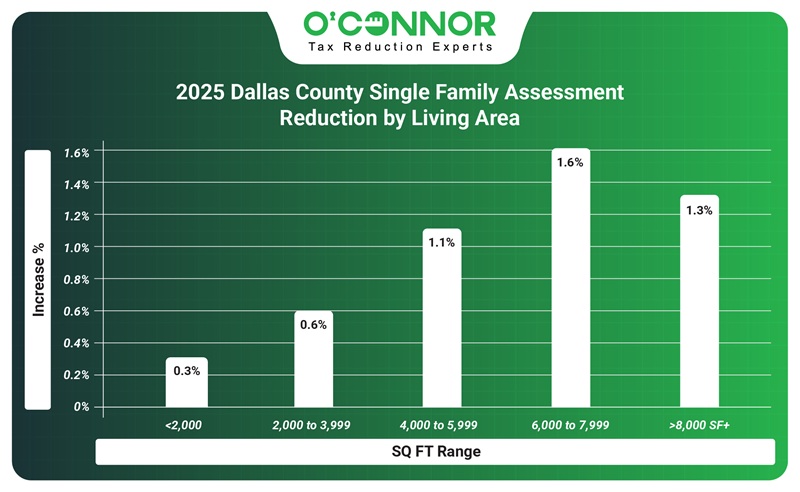
Informal appeals seemed to have a bigger impact on larger homes in 2025. Large homes between 6,000 and 7,999 square feet and the mammoth homes that exceed that scored reductions of 1.6% and 1.3% respectively. In contrast, homes below 2,000 square feet and those between 2,000 and 3,999 square feet netted cuts of 0.3% and 0.6% respectively. The vast majority of Dallas County homes fall into this category. This could simply be because larger homes are protested more often than smaller ones, with owners having more resources. This seems to be the primary reason that informal appeals did not bear much fruit as a whole, as low and middle-income homes were not appealed in significant numbers.

The value of Dallas County homes when looked at by age of construction is surprisingly uniform. Homes constructed before 1960 contributed as much value as those built between 2001 and 2020. The effectiveness of reductions followed suit, with each era being close to one another in both percentages and actual value savings. New construction was the one outlier, as it only represented 5% of value, while getting a 1.3% reduction.
Dallas County Commercial Property Lands 2.9% Reduction

The story of 2025 was that commercial properties across Dallas County exploded in value by 15.1%. This is a large increase that could easily cause problems for both larger and smaller businesses. As it is common for commercial properties to appeal taxes every year, informal appeals have already cut into this growth with a total reduction of 2.9%. DCAD originally appraised all commercial property at $156.22 billion, but it has since been cut to $151.62 billion. Businesses worth more than $5 million saw a reduction of 3.2%, cutting their value from $130.32 billion to $126.15 billion.
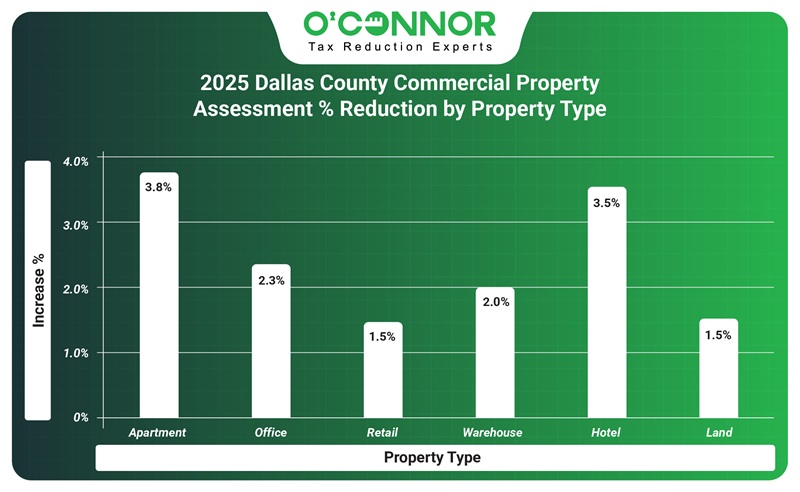
A trend seen in most urban counties is that apartments make up the largest share of fair market value. This is certainly true in Dallas County, where $77.85 billion in value is found in apartments. Informal appeals were able to cut this down by 3.8%, producing a savings of $2.97 billion in value. Offices were second-place in value and received 2.3% in reductions, or a total of $810.01 million. The No. 3 property type, retail, received a modest cut of 1.5%, while hotels saw a large reduction of 3.5%.
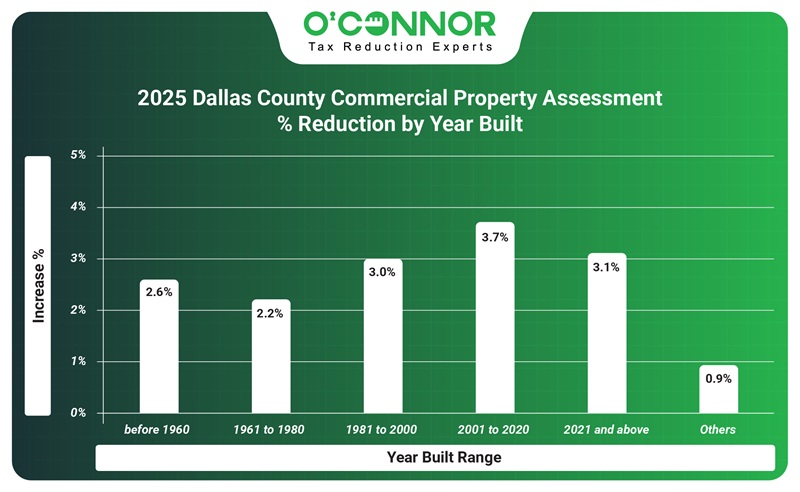
Unlike homes, commercial property value is centered on more recent construction. Those built between 2001 and 2020 represent 32% of all commercial value, followed by those from 1981 to 2001, which was 31% of the value. Those built between 2001 and 2020 were able to land a solid reduction of 3.7%, reducing taxable value by $1.90 billion. Commercial properties constructed from 1981 to 2000 reduced their value by 3%, which rounds out to $1.46 billion. New construction accounted for only 7% of all value but was still able to get a solid $346.81 million knocked off potential tax bills.
Dallas County Apartments Saves $2.97 Billion in Protests
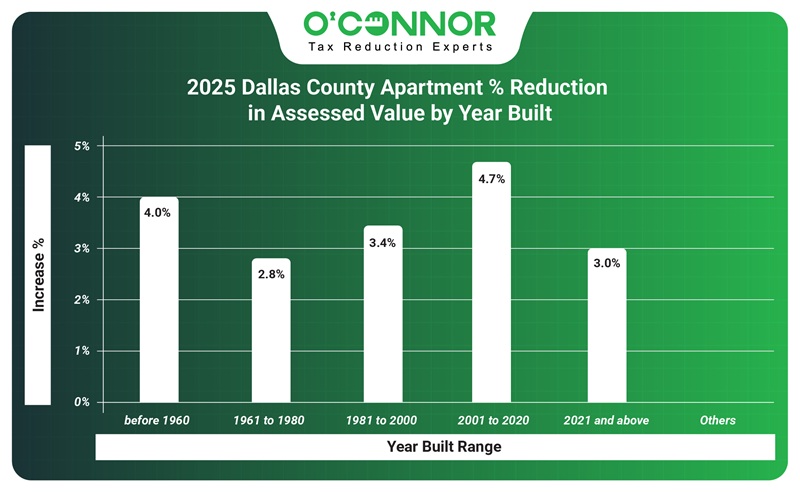
Being the No. 1 commercial property in Dallas when looking at value, apartments made up $77.85 billion in value prior to appeals. Thanks to informal appeals and early formal protests, this number was reduced by 3.8% to $74.88. Apartments built between 2001 and 2020 represented 42% of all taxable value with $32.83 billion, though they also received the largest reduction thanks to protests at 4.7%. Apartments built between 1981 and 2000 accounted for the second-most value at $21.05 and got a reduction of 3.4%. New construction was already responsible for 10% of the total value at $7.54 billion but was knocked down to $7.28 billion thanks to a 3% reduction.
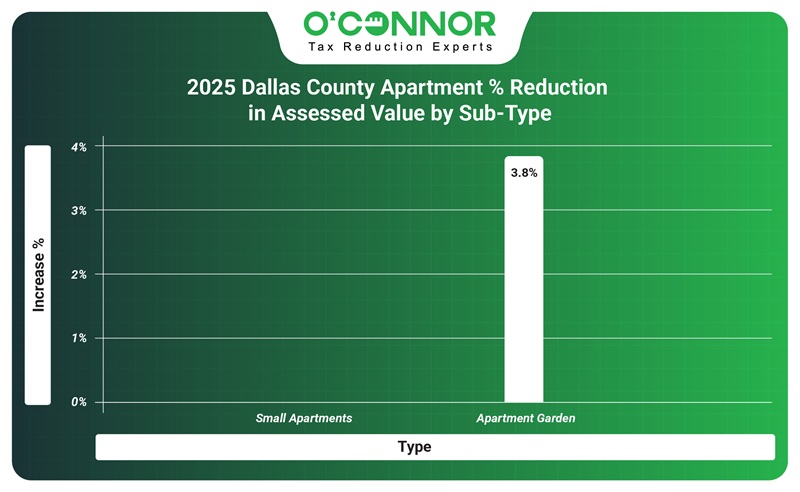
DCAD only divides multifamily housing into small apartments and garden apartments. While this opens up a lot of room for interpretation, it does not give much detail about how Dallas apartments are actually arranged. Garden apartments accounted for $74.88 billion, while also netting a value cut of 3.8%. Small apartments only added $1.11 billion in value, while getting no reductions.
Offices Managed to Appeal 2.3% of Taxable Value
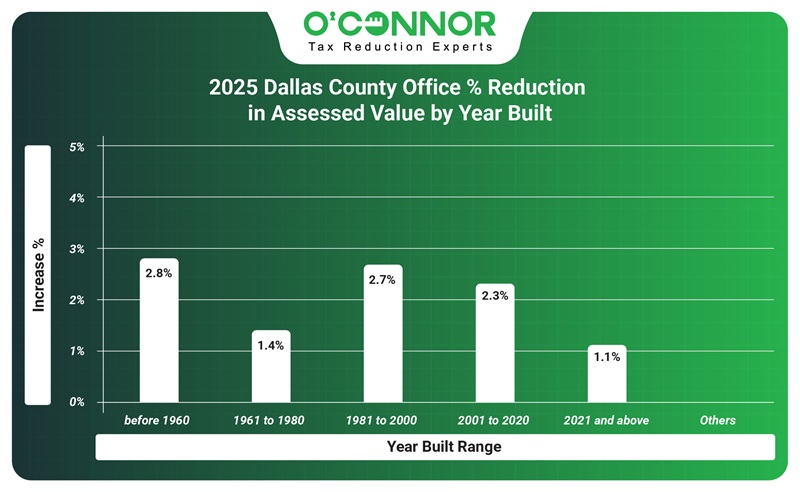
Offices are solidly in the No. 2 spot for commercial property behind apartments. Accounting for $35.36 billion in assessed market value, the 2.3% cut they received thanks to protests was a hardy one. These savings of $810.01 million in value will certainly be improved upon by more ARB appeals. When broken down by the age of construction, we can see that the biggest contributor to both value and reductions are those built between 1981 and 2000. These offices were responsible for 47% of the total value, while getting a reduction of 2.7%. Offices built between 2001 and 2020 totaled $9.90 billion, before getting a reduction of 2.3%.
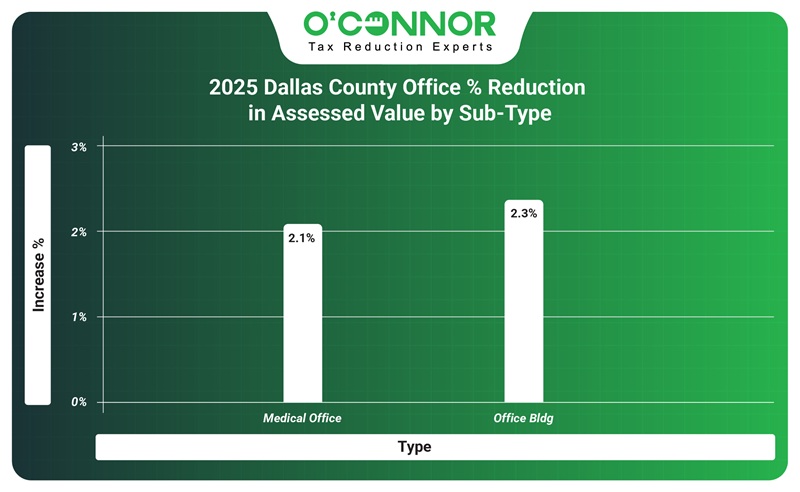
Like apartments, DCAD only breaks offices down into two categories. Since it is a catch-all subtype, office buildings accounted for the majority of property value, totaling $31.40 billion, while medical offices got $3.97 billion. Office buildings managed a reduction of 2.3%, which worked out to a savings of $725.12 million. Medical offices also saved 2.1%, but this translated to a modest $84.88 million in reductions to taxable value.
Strip Malls, Big Box, and Shopping Centers all Save
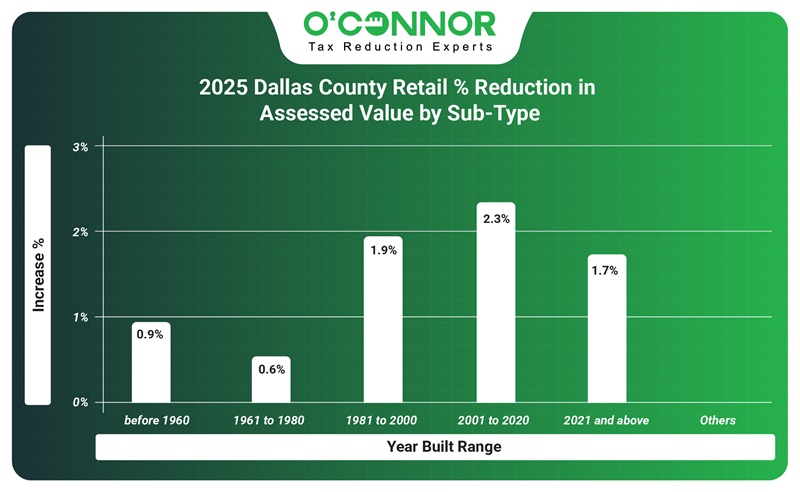
Dallas County retail was valued by DCAD at $14.73 million in 2025, before reducing 1.5% to $14.54 billion thanks to protests. No single construction timeframe for commercial properties ran away with the most value. Those built between 2001 and 2020 saw the largest reduction due to protests with 2.3%, a savings of $83.65 million in value. Those from 1981 to 2000 were able to net a savings of $78.24 million on a reduction percentage of 1.9%.
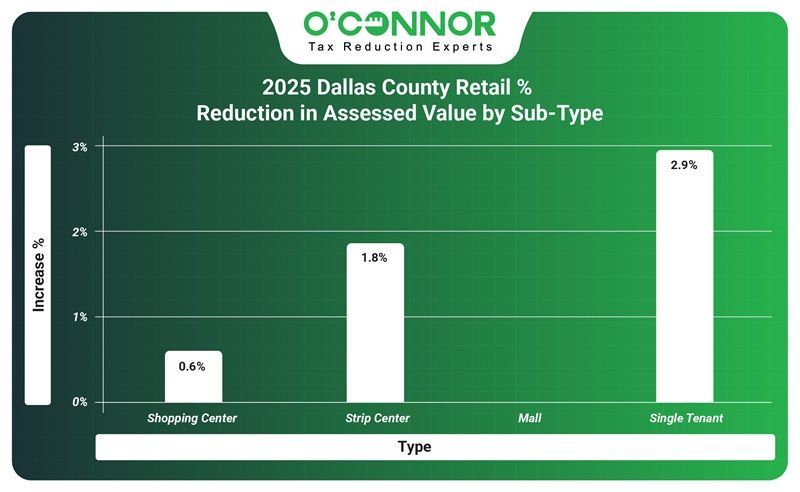
DCAD broke down retail spaces into a few subtypes, making them easy to explore. Strip centers accounted for $6.37 billion in value before protests, where they were lowered to $6.25 billion. Shopping centers were No. 2 with $3.94 billion in total value, before being cut by 0.6%. Single-tenant retail went from $2.62 billion to $2.54 billion thanks to property tax appeals.
Warehouses see Slight Reductions
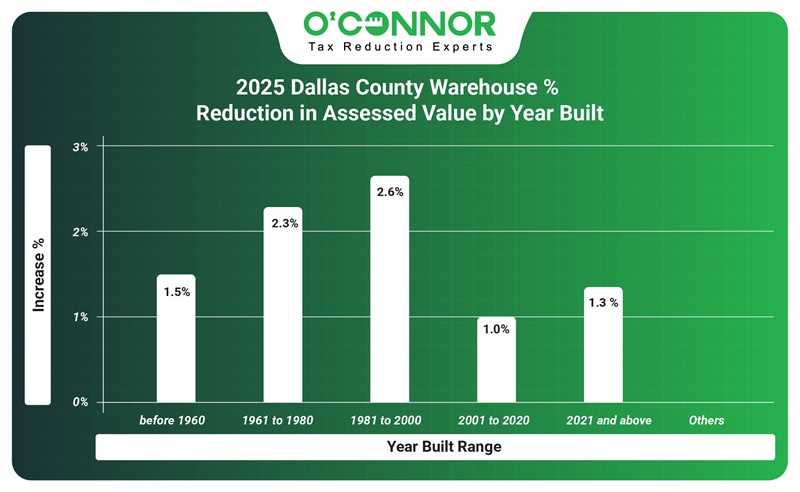
Even in the worst economies, warehouses flourish. Warehouses managed to garner a taxable value of $9.55 billion in 2025. After informal appeals and a few early ARB hearings, this was reduced by 2% to $9.37 billion. The largest amount of value was created by warehouses built between 1981 and 2000, which was 38% of the total. After appeals, warehouses from this timeframe were reduced by 2.6%, leaving a total of $3.59 billion. Warehouses built between 1961 and 1980 contributed 23% of all value, while those built from 2001 to 2020 created 27% of all value. These were protested down 2.3% and 1% respectively.
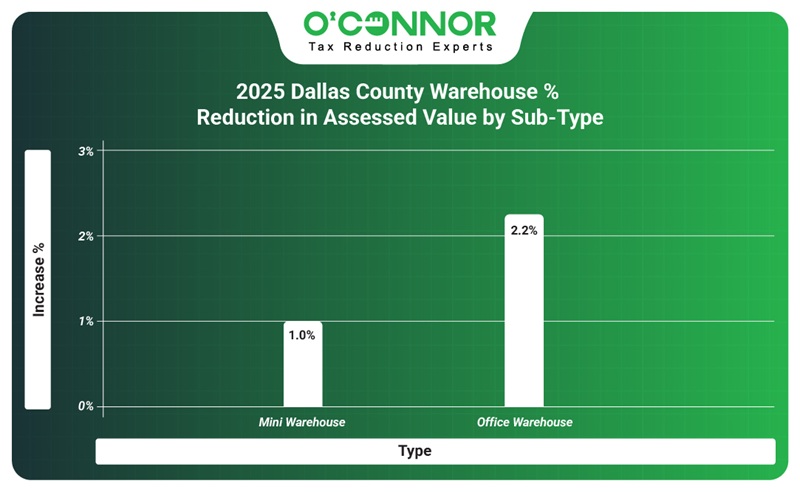
DCAD only breaks down warehouses into the subtypes of mini warehouses and office warehouses. Office warehouses controlled most of the value, with a total of $7.59 billion, while mini warehouses managed $1.96 billion. Protests brought 2.2% in tax relief to office warehouses, producing $168.03 million in savings. With a 1% reduction, mini warehouses managed a cut of $19.01 million.
More Dallas Reductions to Come
As we have seen, the first round of appeals in Dallas County is a mixed bag. They offered small relief across the board, but this is against record increases. Informal appeals may have saved residential properties 0.7% and commercial properties 2.9%, but this is in the face of increases by DCAD that were 5.6% for homes and 15.1% for businesses. This should not be used to detract from the efficacy of informal appeals but should be a strong example of why taxpayers must appeal annually. In 2023, only about 19% of properties in Dallas County were protested. It should be clear that those that wished to fight DCAD were rewarded, while the majority of the county simply complied.
Another thing to remember is that there are still ARB appeals to be counted. These formal hearings can take a while to resolve, as the ARB must hear each case individually. This process may take several months, often resulting in outcomes being returned gradually and intermittently. We will know more about the entire appeal picture in a few months. So, while appeals may seem relatively small, remember that this is not the complete picture. ARB hearings usually return higher savings, especially for commercial properties.
O’Connor is here to help. Though the deadline for informal appeals has passed, there are still ARB hearings to be had. We at O’Connor can be your representative, while also acting as your advocate and researcher. With our proprietary database of home sales, we can bring the best evidence before the ARB. If you did not appeal this year, then that is OK too. We can protest your taxes automatically for you every year. There is no fee to join us, and you will only be charged if we lower your taxes. Don’t let DCAD play you for a fool again next year.

